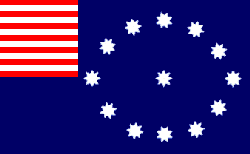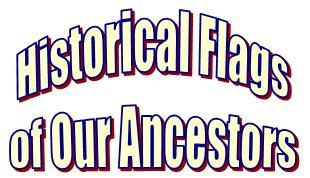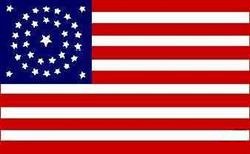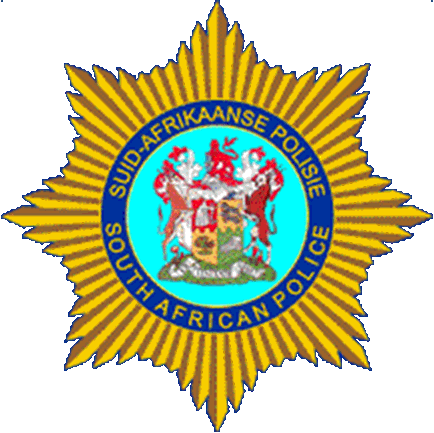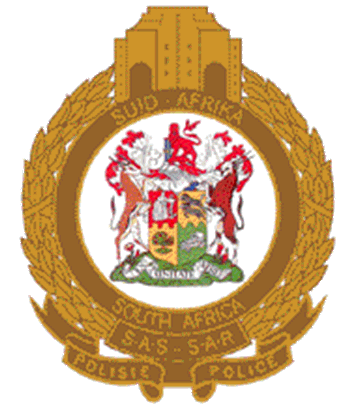Note: If an image ever fails to appear - refresh your page, it really is there
| Early Colonial Flags | Flags of the 19th Century | Flags of the 20th Century | Flags of Modern South Africa |
| Military Flags of South Africa | State and National Police Flags | Homeland Police Badges/Emblems |
| Homeland Coat-of-Arms/Shields | South African Provincial Coat of Arms | South African Governmental Agency Flags |
Military Flags of South Africa
(including National Police Flags)
The South African military organization came into existence as the Union Defence Forces in 1912 as a direct result of the unification of the four Crown Colonies of the Cape of Good Hope, Natal, the Orange River Colony and the Transvaal to form the Union of South Africa on 31 May 1910 - a dominion within the British Empire (later Commonwealth).
The Union Defence Forces initially comprised three arms of service, namely the South African Army (SAA), the South African Air Force (SAAF) and the South African Navy (SAN). In 1979, the South African Medical Services (SAMS) was added as a fourth military arm and changed its name to the South African Military Health Service (SAMHS) after 1994.
Use of the Castle of Good Hope Emblem
The ground plan of the Castle of Good Hope was used as the outline for the emblems of the various constituent arms of service of the South African Armed Forces before 2003. The Castle of Good Hope is the oldest building in South Africa, having been erected by the Dutch East India Company between 1665 and 1679. Since 1679 it has been a seat of military administration of one kind or another, and thus it was considered an appropriate device to be used on the various ensigns of the defence force prior to the new SANDF emblem being adopted in 2003.
Use of the Nine Pointed Star Emblem
The current emblem of the South African Armed Forces is a nine-pointed "Star" representing the warm sun of Africa and the country's nine provinces. The Star is also used in divisional emblems and flags to reflect a common corporate identity coupled to a unique divisional device.
South African Defence Force
The Union Defence Forces came into existence on 01 July 1912 as a direct result of the unification of the four Crown Colonies of the Cape of Good Hope, Natal, the Orange River Colony and the Transvaal to form the Union of South Africa on 31 May 1910 - a dominion within the British Empire (later Commonwealth).
The Union Defence Forces initially comprised three arms of service, namely the South African Army, the South African Air Force and the South African Navy, but in 1994 a fourth branch was added, that of the South African Medical Services.
Following the declaration of a Republic on 31 May 1961, the Union Defence Forces (UDF) were renamed the South African Defence Force (SADF). A further name change followed the adoption of a democratic Constitution on 27 April 1994 and the South African Defence Force became known as the South African National Defence Force (SANDF). The SANDF comprises not only the former SADF, but also the defence forces of the former "independent" Homelands and certain forces which had been part of the liberation struggle, most notably Umkonto weSizwe and the Azanian People's Liberation Army (APLA).
A major reorganisation of the South African Armed Forces took place between 1996 and 2000 resulting in the formation of a Joint Operational Division responsible to command and conduct all military operations. A Division of Joint Support and the Defence Intelligence Division were also created. A change from the former "Castle of Good Hope" emblem to the nine pointed star also occurred at this time.
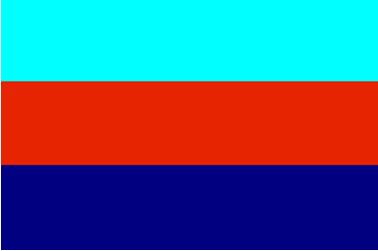
UDF Flag 1947
|
Union Defence Forces 1947-1979
In terms of Union Defence Forces Routine Order No. 1305 of 1947, the colours of the Union Defence Forces were to be [sealed permanent force] orange, sky blue and dark blue to represent the army, air force and navy respectively.
This flag thus made in the proportions of two to three and consisted of three equal horizontal stripes of sky blue, [sealed permanent force] orange and dark blue.
|
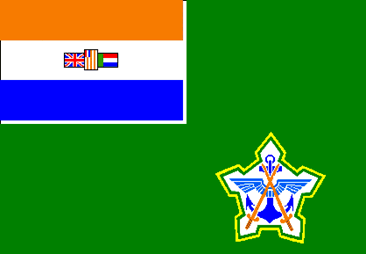
SADF Flag 1981
|
South African Defence Force 1981-1994
Although by 1951 each of the then existing three arms of service of the Union Defence Forces possessed its own distinctive ensign, it was only in 1981 that a distinctive flag was designed for the SADF. This ensign was carried for the first time at a parade held on 01 June 1981 to mark the 20th anniversary of the establishment of the Republic of South Africa.
The ensign of the SADF had a dark green field with the South African national flag in the canton, fimbriated in white, with the SADF emblem in the lower fly
|

SANDF Flag 1994
|
South African National Defence Force 1994-2003
New flags for the SANDF and its constituent services were announced on 19 October 1994 and formally taken into use at a parade held in Pietersburg on 11 November 1994. Apart from the replacement of the national flag in the canton, the new flag of the SANDF was identical to its immediate predecessor.
The new national flag was adopted on 27 April 1994 on the initial day of the first democratic election to be held in South Africa.
|
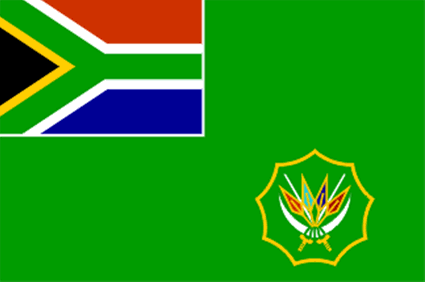
SANDF Flag 2003
|
South African National Defence Force 2003
A suite of new flags for the South African Armed Forces was adopted on 29 April 2003 to reflect the transformation process. A new emblem to replace the Cape of Good Hope Castle outline was also adopted.
The new emblem of the SANDF comprises four spear heads/points and two crossed swords above two tusks in a nine-pointed star outline. The four spear heads are in Service Colours and allude to the four arms of Service within the SANDF (army, air force, navy and military health service) and the nine points of the star represents the nine provinces of South Africa. The tusks are bound together by the four elements representing Chief of Joint Operations (Chief of Joint Operations, Chief of Joint Support, Defence Intelligence and Chief of Corporate Staff) while the swords emphasises the image of the military.
|
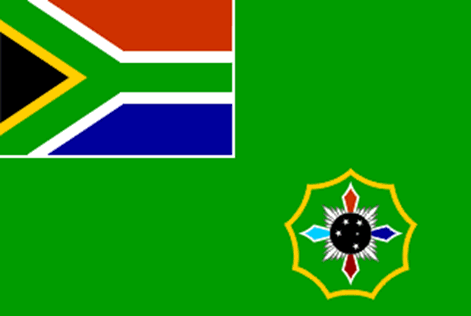
JOD Flag 2003
|
Joint Operations Division
29 April 2003 -
Following the re-organisation of the SANDF, a new flag for the Joint Operations Division was adopted on 29 April 2003. It follows the same design as the flags of the arms of service of the SANDF and has a green field with the national flag, fimbriated in white in the canton, and the badge of the Division in the lower fly.
The badge comprises four spear points, pointing to the cardinal compass points, containing the Service Colours within a yellow nine-pointed star. This represents the mission of Joint Operations, which is to command troop deployments where ever this might be. The Southern Cross is indicative of the southern hemisphere where South Africa is situated.
|
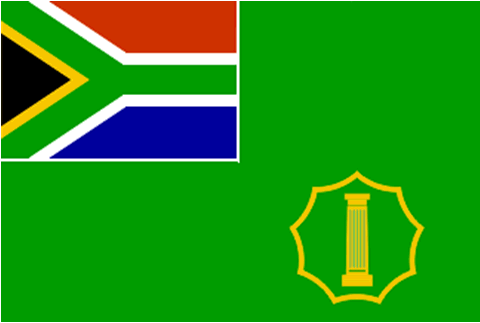
JSD Flag 2003
|
Joint Support Division
29 April 2003 - 31 March 2006
Following the re-organisation of the SANDF, a new flag for the Joint Support Division was adopted on 29 April 2003. It follows the same design as the flags of the arms of service of the SANDF and has a green field with the national flag fimbriated in white in the canton, and the badge in the lower fly. The badge comprises a yellow fluted pillar, symbolising support from a variety of disciplines, within a yellow nine-pointed star outline.
This Division was disbanded on 31 March 2006 and consequently this flag is no longer in use.
|
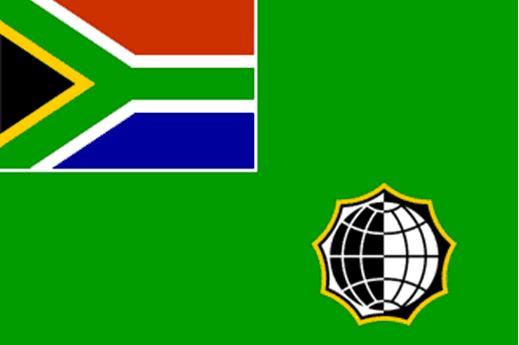
DID Flag 2003
|
Defence Intelligence Division
2003 -
Following the re-organisation of the SANDF, a new flag for the Defence Intelligence Division was adopted on 29 April 2003. It follows the same design as the flags of the arms of service of the SANDF and has a green field with the national flag, fimbriated in white in the canton, and the badge in the lower fly.
The badge comprises a black and white globe within a yellow nine-pointed star outline. The badge of Defence Intelligence symbolises the global nature of their field of responsibility, with the colours indicating the need to separate fact from falsehood as well as to symbolise the role of the division of shedding light into darkness.
|
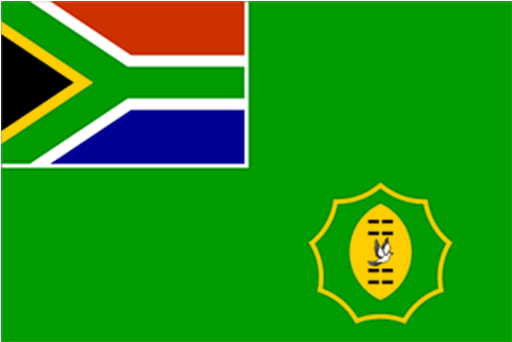
DMV Flag 2010
|
Department of Military Veterans
2010 -
The Department of Military Veterans (DMV) was proclaimed in the Government Gazette of 28 December 2009. The Department is responsible for the overall management and administration of military veterans' affairs including, but not limited to, developing legislation, policy, programmes, benefits and services that facilitate the transition from active service to civilian life.
The flag of the new DMV follows the standard pattern of SANDF flags adopted in April 2003 with the emblem of the Department in the fly of a green SANDF ensign. The emblem comprises an African shield in yellow in the centre of a nine-pointed star used by all the arms of the SANDF. In the centre of the shield is a white dove in flight.
|
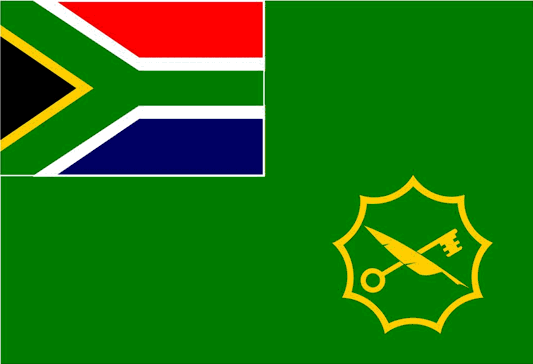
DHR Flag 2010
|
Department of Human Resources
2010 -
A Department of Human Resources within the SANDF was established in 2010 and adopted a distinctive flag based on the standard SANDF pattern, namely having the badge of the Department in the fly of a dark green ensign with the South African national flag, fimbriated in white, in the canton
|
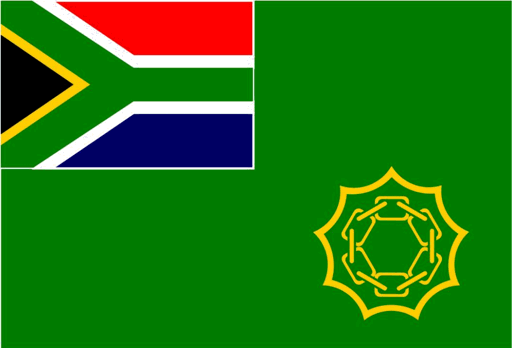
DOL Flag 2010
|
Department of Logistics
2010 -
A Department of Logistics within the SANDF was established in 2010 and adopted a distinctive flag based on the standard SANDF pattern, namely having the badge of the Department in the fly of a dark green ensign with the South African national flag, fimbriated in white, in the canton
|
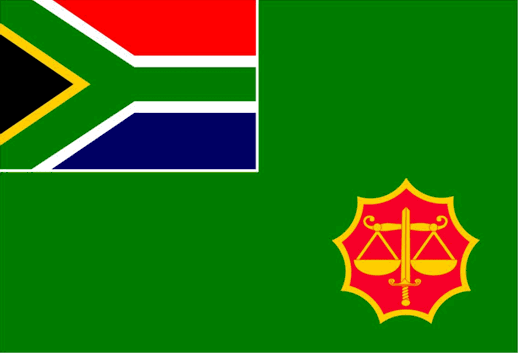
DLS Flag 2010
|
Department of Legal Services
2010 -
A Legal Services Department within the SANDF was established in 2010 and adopted a distinctive flag based on the standard SANDF pattern, namely having the badge of the Department in the fly of a dark green ensign with the South African national flag, fimbriated in white, in the canton
|
Note: The Chief of the Corporate Staff Division elected not to have a flag, thus making it the only Division within the SANDF not to have a flag.
South African Army
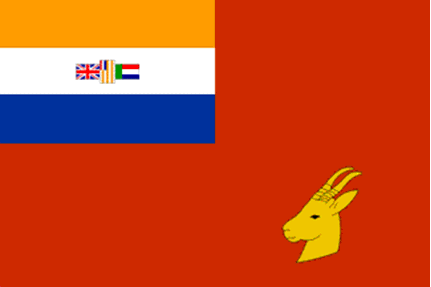
SAA Flag 1951
|
South African Army 1951-1966
The first flag for the South African Army was created by Routine Order No. 1705 of 1951 and specified that it should be of the following design: "a rectangular [sealed permanent force] orange flag in the proportions of two to three; within the upper hoist quarter the national flag of the Union of South Africa; and in the lower fly quarter a gold springbok head, the height of which should be equal to one-third of the width of the flag."
A special note on the colour used by the South African Army which is always called orange when in fact the exact shade is a more reddish colour. Early in the history of the South African military it became necessary to have a colour for various purposes and a reddish shade was selected which was distinct from the orange found in the then national flag of South Africa. The chosen shade was then "sealed" by the defence force authorities and thereafter became known as "sealed permanent force orange", originally identified as British Colour Council 97 (poppy). In the 1970s this was changed to BCC98 (chilli).
|
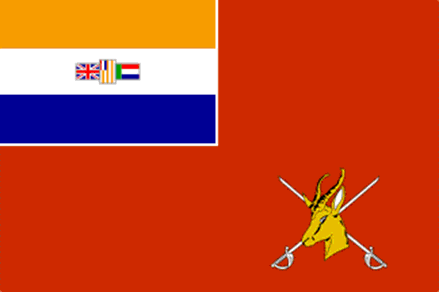
SAA Flag 1966
|
South African Army 1966-1973
The Army flag was amended on 16 November 1966 when the High Command of the SADF approved an amendment to the design of the Army emblem whereby the springbok head was now to be placed in the front of two silver crossed swords.
|
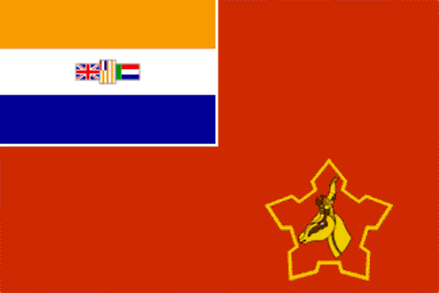
SAA Flag 1973
|
South African Army 1973-1994
There had been some confusion surrounding the design of the springbok head used by the South African military prior to 1973. To rectify this position in so far as the Army was concerned, and also to avoid confusion with the designs of the shoulder-flashes worn by the various members and commands, a new emblem for the South African Army was designed.
On 16 February 1973, a new flag for the South African Army was also approved whereby the new army emblem with the springbok head placed in the centre of the Castle of Good Hope outline was placed in the fly. This design remained unaltered when all the flags and emblems of the SADF were standardised in 1981 based on the Castle outline.
|
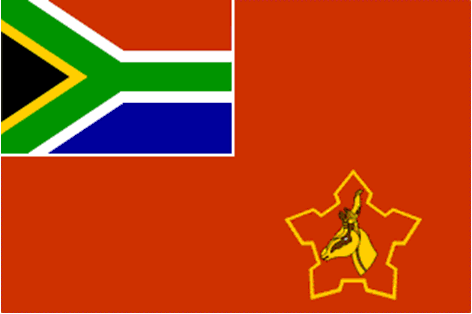
SAA Flag 1995
|
South African Army 1995-2000
Following the adoption of the new South African national flag on 27 April 1994, a new flag design for the South African Army was approved by the Chief of the now renamed South African National Defence Force (SANDF) on 11 August 1994.
With the exception of the new national flag in the canton, this flag is identical to that used previously by the South African Army and was carried for the first time at a Defence Force parade held in Pietersburg on 11 November 1994.
|
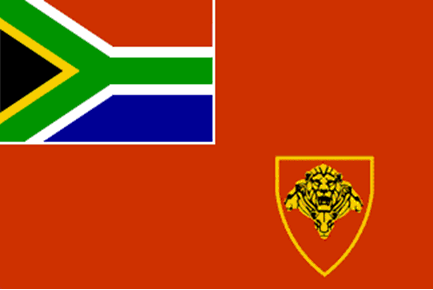
SAA Flag 2000
|
South African Army 2000-2003
New Army badge and rank insignia were adopted in March 2000 which resulted in the Castle of Good Hope outline being dropped. Consequently a new flag for the South African Army was introduced in April 2002 with the new emblem in the fly.
The new emblem comprised three conjoined lions' heads above one lionesses head (the so-called "pride of lions") in gold in the centre of a red shield. This design was never registered with the heraldic authorities due to a perceived resemblance to the design used by India as a national emblem which is derived from the so-called Ashoka Pillar.
|
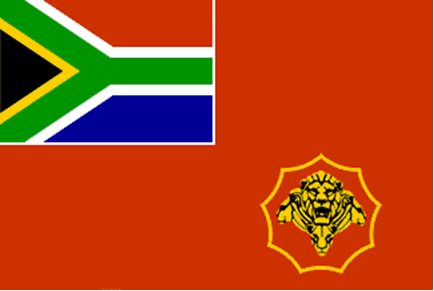
SAA Flag 2003
|
South African Army 2003 -
At a Retreat Ceremony held on 25 April 2003, the old SANDF emblem, based on the Cape Castle outline, was formally phased out. The new SANDF emblem, incorporating a nine pointed "star" representing the warms sun of Africa and the nine provinces of South Africa, was formally presented to the Chief of the Defence Force on 29 April 2003.
With the exception of the badge in the fly, the new Army flag is identical in colour and overall design to its immediate predecessor and incorporates the lions´ heads in the centre of a nine-pointed star.
|

SAAC Flag 1970
|
South African Army Commando Units
1970-2005
The Commando Units of the SANDF served as adjuncts to the regular armed forces and in their latest incarnation were essentially intended as an area-bound "Home and Hearth" rear protection light infantry force.
The flag used by the Commandos had a green background containing a saffron saltire with a white fimbriation. It is thought that the saltire motif was based on the Voortrekker flag used in the 19th century which was a blue flag with a red saltire and was the national flag of the Transvaal for a short period.
|
South African Air Force
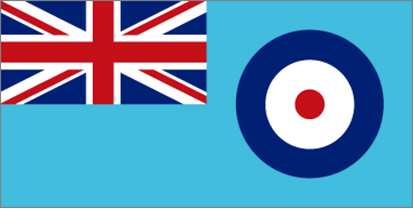
SAAF Flag 1920
|
South African Air Force 1920-1940
The SAAF is the second oldest air force in the world and was formed in 1920. At the time of its formation, South Africa was a Dominion within the British Empire and the SAAF originally used the ensign of the British Royal Air Force until a distinctive SAAF ensign was adopted in December 1940.
|
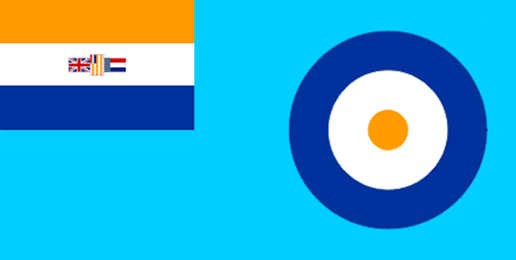
SAAF Flag 1940
|
South African Air Force 1940-1951
On 03 December 1940 Air Directorate Order No. 212/1158 stipulated that the "South African Air Force ensign was to be flown at all Air Force Stations with the ensign of the Royal Air Force (RAF)". On 17 December 1940 a General Order created the first distinctive ensign for the SAAF.
This was based on the same design as that used by the RAF but with the South African flag in the canton and a roundel composed of the South African national colours, namely three concentric, equally wide rings, from the outside inwards of dark blue, white and orange, in the fly.
|
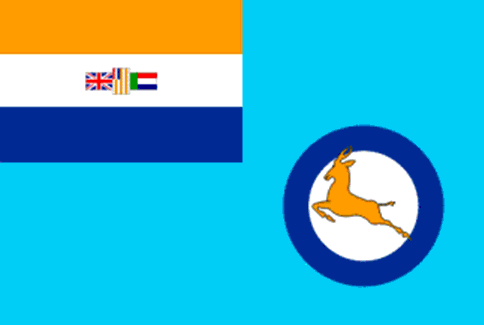
SAAF Flag 1951
|
South African Air Force 1951-1958
In terms of Routine Order 1705 of 1951, a new emblem was created for the SAAF and the ensign of the SAAF.
The major change was that the proportions of the flag were now to be the same as that of the national flag (2:3) and a new emblem in the fly would contain an orange coloured springbok leaping towards the hoist on a white field encircled by a dark blue ring.
|
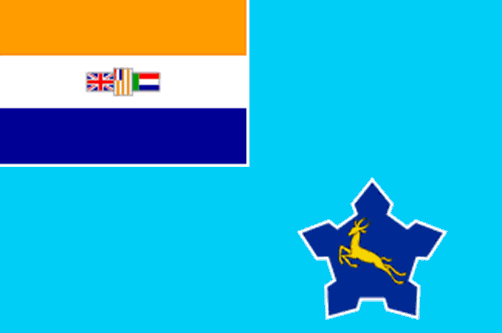
SAAF Flag 1958
|
South African Air Force
1958-1967
In 1958, shortly after the adoption by the Union Defence Forces of a five pointed-castle emblem as a badge of rank to replace the British Crown, the South African Air Force took into use a new ensign.
It differed from the previous ensign in that the roundel encircling the leaping Springbok was replaced by the ground plan of the Castle of Good Hope in dark blue, edged in white, with the leaping Springbok in gold.
|
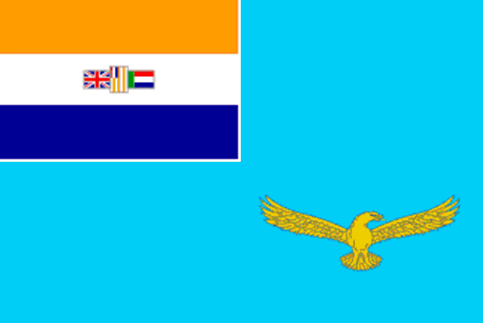
SAAF Flag 1967
(designed but never flown)
|
South African Air Force 1967-1970
On 16 November 1966 the High Command of the SADF approved Air Force Order No. 26 of 1966 whereby the Castle of Good Hope and leaping springbok emblem used on the Air Force ensign since 1958 were replaced by the badge of the SAAF, namely a gold eagle with its head turned sinister and its wings outspread and standing upon a scroll bearing the words Per Aspera Ad Astra. Subsequently on 21 January 1967, Air Force order No. 2 of 1967 set aside Order No. 26 of 1966 and specified that the scroll and motto should be dropped from the emblem in the fly. It was stipulated that the new ensign would only replace that stipulated in Air Force Order No. 26 of 1966 once stocks of the earlier ensign were exhausted.
This version of the SAAF ensign was in fact never flown as Air Force Order No. 1 of 1970 on 26 March 1970 reintroduced the third design of the SAAF ensign with the leaping springbok against the Castle of Good Hope background in the fly which had been used since 1958.
|
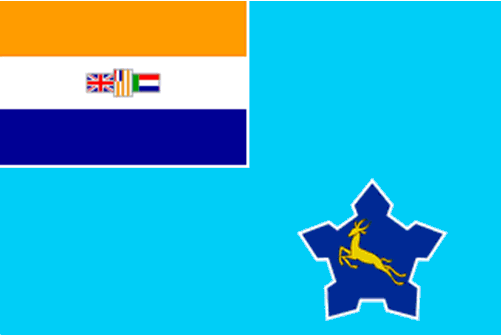
SAAF Flag 1970
|
South African Air Force 1970-1981
Air Force Order No. 1 of 1970 on 26 March 1970 re-introduced the third design of the SAAF ensign with the leaping springbok against the Castle of Good Hope background in the fly which had been used since 1958.
|
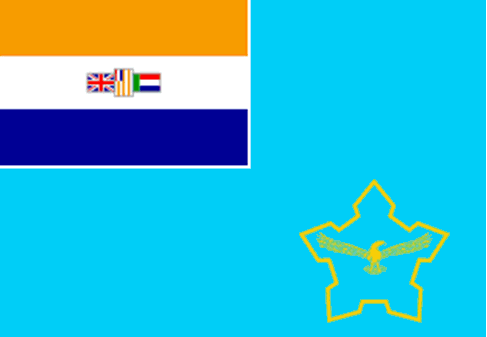
SAAF Flag 1981
|
South African Air Force 1981-1982
A further change occurred on 03 March 1981 when the emblem in the fly was changed to that of a gold representation of the South African Air Force eagle within a Castle of Good Hope outline, also in gold.
This emblem in gold was found to be difficult to distinguish and accordingly the colours of the emblem were modified in February 1982.
|
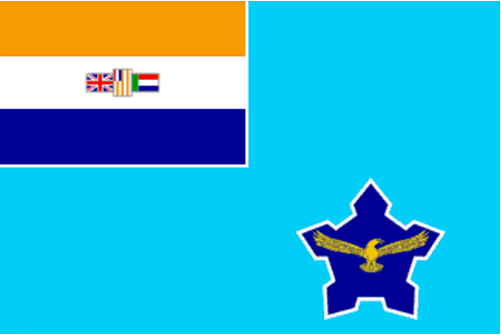
SAAF Flag 1982
|
South African Air Force
1982-1994
The amended design of the SAAF ensign came into use on 27 February 1982. The background of the ground plan of the Castle of Good Hope was changed to the same shade of (dark) blue as that used in the bottom stripe of the then national flag. The border around the emblem was also changed from gold to white.
|
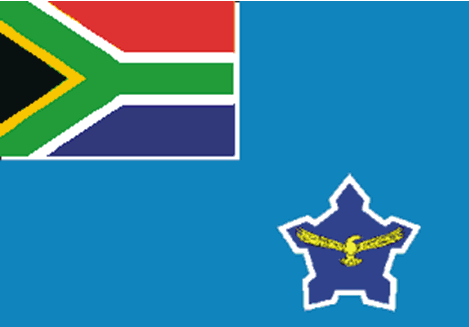
SAAF Flag 1994
|
South African Air Force
1994-2003
Following the adoption of the new South African national flag on 27 April 1994, a new flag design for the SAAF was approved by the Chief of the now renamed South African National Defence Force (SANDF) on 11 August 1994.
With the exception of the new national flag in the canton, this flag is identical to that used previously by the SAAF and was carried for the first time at a Defence Force parade held in Pietersburg on 11 November 1994.
|
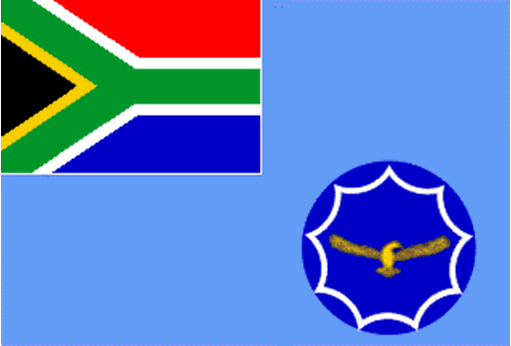
SAAF Flag 2003
|
South African Air Force
2003 -
At a Retreat Ceremony held on 25 April 2003, the old SANDF emblem, based on the Cape Castle outline, was formally phased out. The new SANDF emblem, incorporating a nine pointed "star" representing the warms sun of Africa and the nine provinces of South Africa, was formally presented to the Chief of the Defence Force on 29 April 2003.
With the exception of the badge in the fly, the new SAAF ensign is identical in colour and overall design to its immediate predecessor and incorporates a golden air force eagle in centre of a nine-pointed star.
|
South African Navy
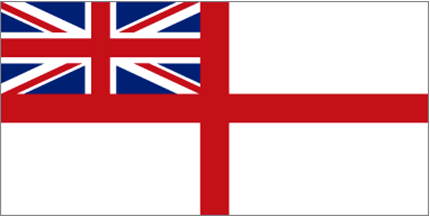
SANS Flag 1922
|
South African Naval Services 1922-1933, 1939-1946
The South African Naval Services was formed in 1922 and its ships wore the White Ensign of the British Royal Navy. The South African Naval Services was disbanded on 01 April 1933, but was resuscitated following the beginning of World War II in 1939.
To distinguish these vessels as South African, the prefix HMSAS was used and in addition to the Royal Navy White Ensign at the stern, these vessels would also fly the national flag of South Africa as a jack. |
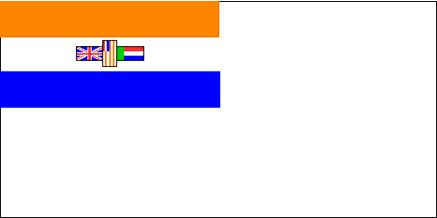
SANS Flag 1946
|
South African Naval Services
1946-1951
The first specifically South African naval ensign was taken into use on 01 September 1946 and comprised a plain white field with the South African national flag in the canton.
This design was not a good flag from a practical point of view as it was difficult to identify at sea in conditions of bad visibility and a new design was proposed on 15 May 1951.
|
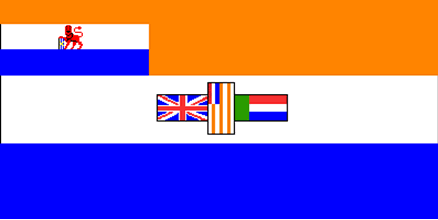
SANS Flag 1951
(designed but never flown)
|
South African Naval Services 1951-1952
A new naval ensign was approved on 31 May 1951 took the form of the South African national flag defaced in the canton by three equally wide horizontal stripes from top to bottom of orange, white and blue. The white stripe of the canton was charged with a lion passant guardant Gules, supporting with the dexter paw four staves erect, alternatively Argent and Azure and banded Or, from the crest of the Coat of Arms.
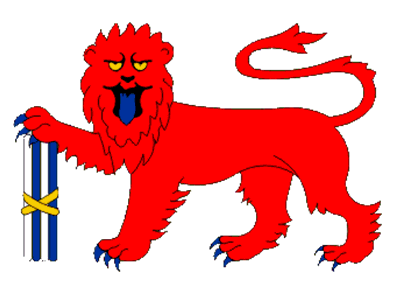
Detail of Lion Charge
This design did not find favour in naval circles and it was never used. Furthermore, no notification of the approval of this design appeared in the Government Gazette.
|
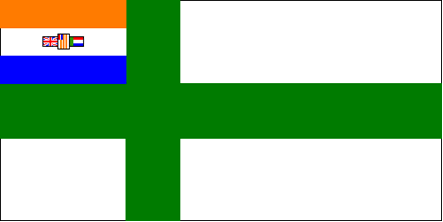
SAN Flag 1952
|
South African Navy
1952-1959
On 14 November 1952 notice was given under Government Notice No. 2633 in the Government Gazette that with effect from 25 March 1952, the South African navy had adopted as its ensign "a dark green cross on a white background with the Union National Flag in the upper canton next to the hoist". This notice cancelled Government Notice No. 1550 of 26 July 1946, in terms of which the first South African naval ensign had been adopted.
The choice of dark green for the cross in 1952 has influenced all subsequent naval ensigns used in South Africa. HH Smith (1993) reports that green may have been chosen rather than red in order for the ensign to be distinguishable from the British White Ensign, with the choice of the colour being influenced by the vertical stripe at the hoist of the Vierkleur of the South African Republic.
|
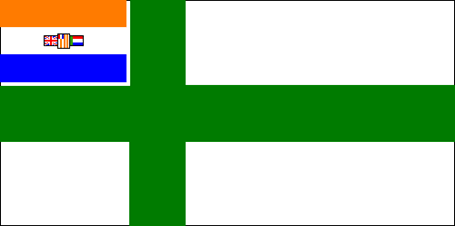
SAN Flag 1959
|
South African Navy 1959-1981
A modification to the design occurred in 1959 in terms of South African Defence Force Order No. 63, in which it was stated that the national flag should be separated from the dark green cross by a narrow white fimbriation.
|

SAN Flag 1981
|
South African Navy
1981-1994
On 31 May 1981, a new ensign came into use. This flag changed the proportions of the naval ensign to 2:3. The green cross on a white background with a fimbriated national flag in the canton was retained.
However, the naval badge in the form of the crest of the South African Coat of Arms on a blue ground plan of the Castle of Good Hope, was now placed in the lower fly quarter. This flag was flown until 26 April 1994.
|
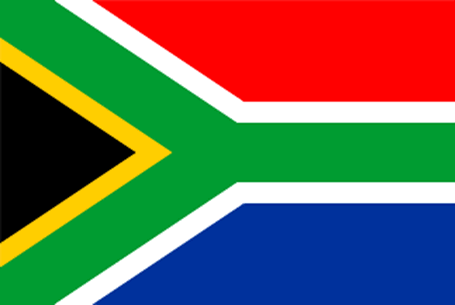
SAN Flag 1994
|
South African Navy Flag
1994
From 27 April 1994 until 11 November 1994, the South African Navy used the new national flag, adopted on 27 April 1994, as the naval ensign.
|
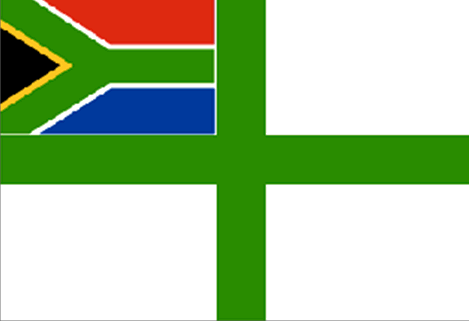
SAN Ensign 1994
|
South African Navy Ensign 1994 -
On 11 November 1994 the current South African naval ensign was taken into use. The naval badge was removed from the lower fly and the old national flag has been replaced with the current national flag in the canton.
The ensign is unlike the other flags of the arms of service of the South African National Defence Force in that navy badge does not appear in the lower fly.
|
South African Medical Service
The South African Medical Services was constituted on 01 July 1979 and changed its name to the South African Military Health Service after 1994.

SAMS Flag 1979
|
South African Medical Services
1979-1994
The South African Medical Services were constituted as the fourth arm of service of the South African Defence Force on 01 July 1979.
Its flag consisted of a ruby field with a fimbriated national flag in the canton. The badge of the medical services was placed in the lower fly quarter. This badge consisted of a gold outline plan of the Castle of Good Hope, a field of ruby red, and a gold snake coiled around a gold staff. On 05 March 1981 a revised design was approved whereby certain colour codes were changed although the design itself remained the same.
|
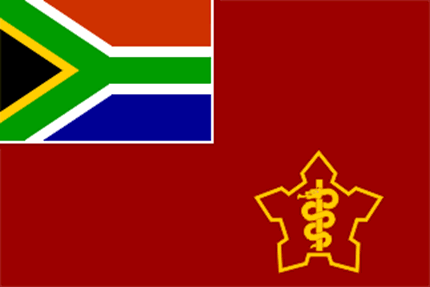
SAMS Flag 1994
|
South African Medical Services
1994-2003
Following the change in the South African national flag on 27 April 1994, a new flag was taken into use on 11 November 1994. This flag has the same design as its predecessor except for the new national flag in the canton.
|
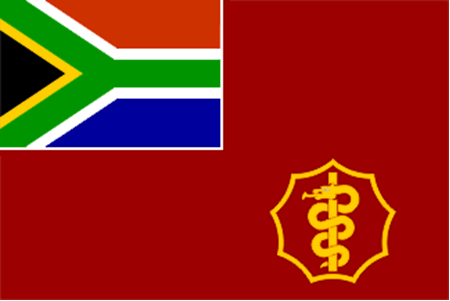
SAMHS Flag 2003
|
South African Military Health Services
2003 -
Following the replacement of the Castle of Good Hope outline with the nine-pointed star emblem of the SANDF, the flag of the re-named South African Military Health Services was amended accordingly and the modified design was taken into use on 29 April 2003.
|
South African Police and Prison Flags
Although not part of the military, the flags of the South African police and prison services follow the same general design pattern as used in the military flags and are shown below.

SAP Flag 1983
|
South African Police
1983-1994
The South African Police was the successor to the police forces of the Cape Colony, the Natal Colony, the Orange River Colony and the Transvaal Colony. It was formed in 1913 after the establishment of the Union of South Africa on 31 May 1910.
A distinctive flag for the South African Police was registered with the South African Bureau of Heraldry on 14 October 1983. It had a dark blue background, divided horizontally in the centre by a single yellow stripe one-seventh the width of the flag. The former national flag of South Africa was in the canton (fimbriated in white at the fly) and the police badge was in the lower fly.
This flag flew alongside the South African national flag at all police stations.
This flag ceased to be used following the adoption of a new national flag on 27 April 1994. |
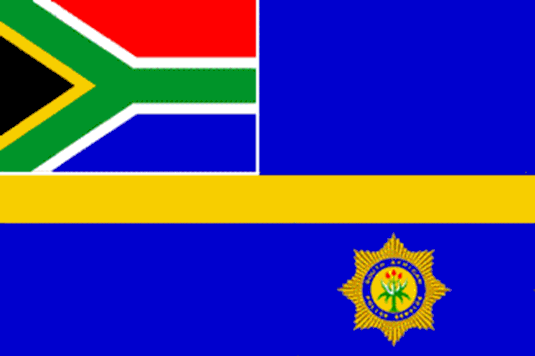
SAPS Flag 1997
|
South African Police Service
1997 -
The South African Police Service (SAPS) was formed in 1995 following the amalgamation of the South African Police and the police forces of the former Homelands.
The flag of the SAPS was registered with the South African Bureau of Heraldry on 17 October 1997 and follows the same pattern as its predecessor but with the new national flag in the canton and the new police badge in the lower fly.
This flag flies alongside the South African national flag at all police stations.
|
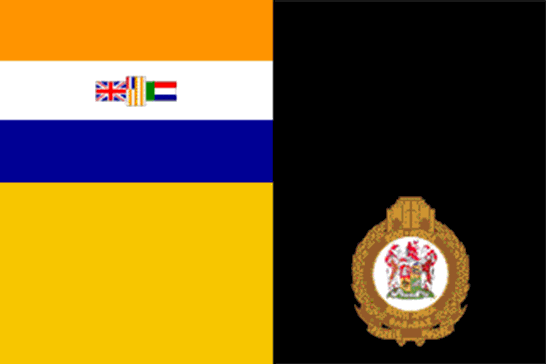
SARP Flag 1986
|
South African Railways Police
1986-1989
The South African Railways Police was a division of the South African Railways and Harbours Administration responsible for transport policing, including airport and harbour security.
A flag for the South African Railways Police was registered with the South African Bureau of Heraldry on 07 February 1986. The flag was divided vertically with the South African national flag in the canton and the lower hoist being gold, with the fly having a black background containing the badge of the Railways Police in the lower fly.
This flag ceased to be used following the merger of South African Railways Police with the South African Police in 1989.
|
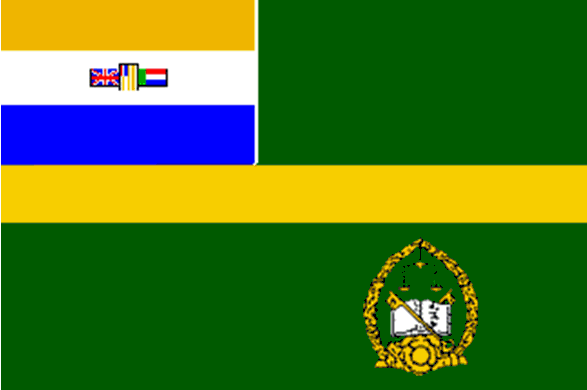
DOC Flag 1986
|
South African Department of Correctional Services 1986-1994
The Department of Correctional Services is responsible for the management of South Africa's prisons.
The flag of the South African Department of Correctional Services is green with a gold horizontal stripe one-seventh of its width, with the South African national flag in the canton fimbriated in white on its fly end. The badge of the service is found in the lower fly comprising two gold keys, an open book and a wreath of Proteas.
This flag was registered with the South African Bureau of Heraldry on 27 March 1992 and ceased to be used following the adoption of the new South African national flag on 27 April 1994. This flag flew alongside the South African national flag at all prisons.
|
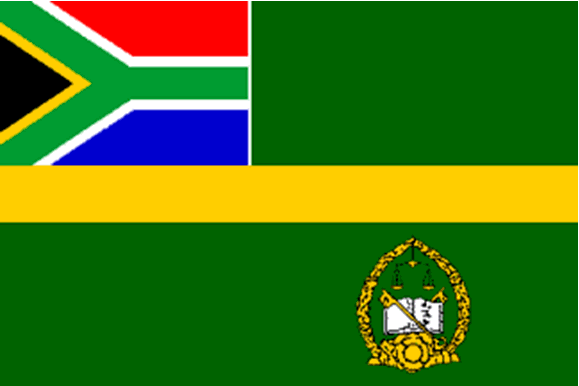
DOC Flag 1994
|
South African Department of Correctional Services 1994 -
A new flag for the South African Department of Correctional Services was registered with the South African Bureau of Heraldry on 12 January 1996. This flag follows the same design as its predecessor but with the new South African national flag in the canton.
This flag flies alongside the South African national flag at all prisons.
|
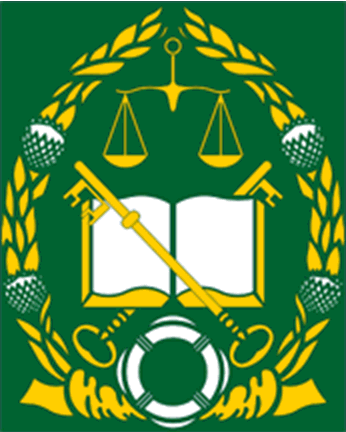
Detail of DOC Emblem
|
Police and Correctional Services' Emblems used on Flags
|
|
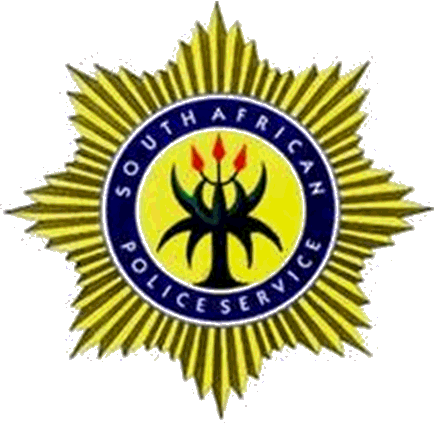 |
|
|
Detail of SAP Emblem |
|
Detail of SAPS Emblem |
|
Detail of SARP Emblem |
|
- My thanks to Bruce Berry for his invaluable help on this page -
|
